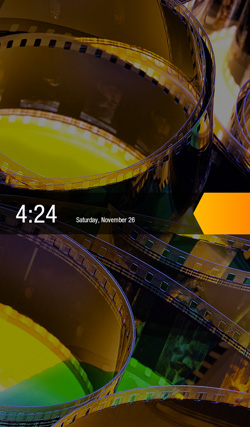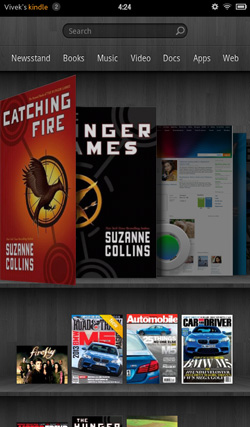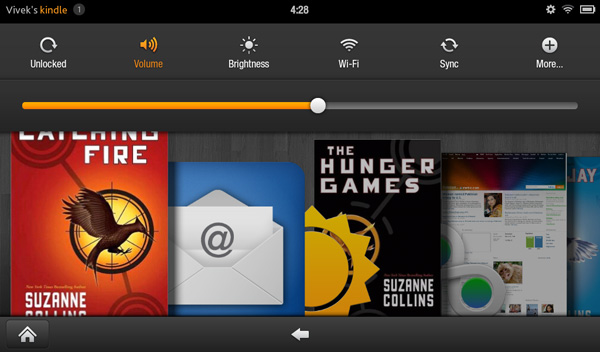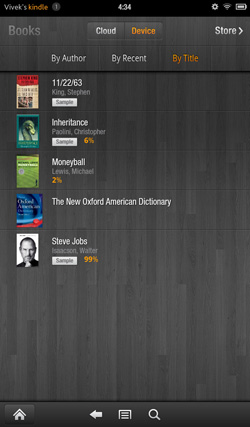Amazon Kindle Fire Review
by Anand Lal Shimpi & Vivek Gowri on November 29, 2011 3:31 AM EST- Posted in
- Tablets
- Mobile
- Amazon
- Kindle Fire
- Kindle
The Operating System
There are three reasons why the Kindle Fire is one of the most important tablet releases of the year: software, services, and shopping. The hardware, while nice, plays a definite secondary role here. The user experience, with tight-knit integration with Amazon's full suite of digital media services (Kindle, Appstore for Android, MP3 Cloud Player, and Prime Instant Video), is what makes the Kindle Fire the most formidable threat.
Amazon and Lab 126 have taken the same route as Barnes and Noble here and built the Kindle Fire operating system on top of Android 2.3. This is basically a skinned version of Gingerbread just as you'd find on an HTC Flyer or the old Galaxy Tab 7", but instead of augmenting the stock Android experience, the goal here is to hide it entirely. When you press the (stupidly located) lock button, you're treated to a simple lock screen, featuring a high resolution image of Amazon's choosing and an orange lock slider with the day, date, and time. Note that you cannot change the lockscreen image without rooting the device.
Slide the bar over to get to the homescreen, and you find yourself looking at a virtual bookshelf of apps. The top shelf is called the Carousel. It's a rotating, Cover Flow-style list of recently used files and applications that you can swipe through. It's nice, in that you can switch between your recent windows, but there's too many app windows that are stored. This leads to two problems: there can be some choppiness in the animation if you try to scroll through the entire list quickly, and overall it's a bit visually chaotic and disorganized. It's good, but it'd be better if they shortened the list to just the last 8-10 items. The shelves underneath are made up of items you deem "favorites". You can pin almost any content to the mainscreen - applications, magazines, newspapers, books, albums, playlists, videos, documents, websites; just hold down the icon/cover to add to favorites, then it'll show up on your homescreen. 4 icons per shelf, and the size of your bookshelf grows downwards as you add more content to it. However, as you add more content, scrolling through the bookshelf tends to get a bit choppy.
The notification bar from Android 2.x is still there, but the notification drawer is a push-button affair instead of a slide-down windowshade. The left side of the notification bar contains the battery and WiFi indicators as well as a small gear. Press it to bring down the quick setting options, and select "More..." to get to the full settings menu. The quick settings options are the rotation lock, volume and brightness controls, wireless settings, and a manual sync button. The main menu settings are relatively limited compared to normal Android, mostly account and security options, along with the standard device settings: sounds, display timeout, keyboard, network, date/time, and application permissions. The notification tone catalogue is basically lifted from Honeycomb, as are the keyboard touch sounds. The sounds are basically the only personalization options you've got. There's no real wallpaper to speak of other than the dark gray bookshelf, and as mentioned before, you can't touch the lockscreen images.
There are no hardware buttons, so the standard Android navigation buttons show up on a bottom navigation bar. The Home button and back button are always present, joined by the menu button and search when relevant. The menu bar disappears when you're viewing print or video content, necessitating a touch of the screen to bring up the navigation bar.
Above the Carousel is a list of the different content areas. You can access the web or one of the content libraries by hitting the corresponding name: Newsstand, Books, Music, Video, Docs, Apps, Web. Web takes you to the browser, Apps takes you to the main application launcher, and the rest of the content areas are mostly self-explanatory. It's the only way to access the browser, the launcher, and the music player, so you'll use those buttons often. Above the content libraries is a search box that searches through your books, magazines, documents, movies, music, and apps. We'll cover all of these systematically, starting with the browser, which Amazon says is "cloud-accelerated" using the computing back-end of Amazon Web Services. It's called Silk.















70 Comments
View All Comments
tiffanykennedy - Wednesday, November 30, 2011 - link
My bf got me a Kindle Fire for my birthday and I love it. It's lightweight and easy to use straight out of the box. The first thing I recommend anyone with a new Kindle do is install the nook app. We got our instructions from www.kindlemad.com through google.It basically unlocks all the Android marketplace apps and unlocks the device. Super happy!
Reflex - Wednesday, November 30, 2011 - link
I would strongly suggest rerunning the performance tests. Just my subjective point of view, but perf just got a major boost. The browser is certainly faster, and so is the book reader. The UI and tap response also seem much improved. All of the Fire's on the market should autoupdate in the next couple days...VivekGowri - Wednesday, November 30, 2011 - link
Downloading, I'll post my findings later today :)Reflex - Wednesday, November 30, 2011 - link
Thanks, wanting to make certain I'm not imagining things.Reflex - Sunday, December 4, 2011 - link
Any update on this? Or waiting for the Nook Tablet review?Chaser - Wednesday, November 30, 2011 - link
As I have stated I don't believe the Fire will TAKE marketshare from Apple. But just like the airline price wars of the 80s and 90s, the Fire with its undeniable market recognition will put A tablet in the hands of those that would not have considered a tablet before.With Apple holding 90% of tablet sales I personally only see iPads in use when I am on business travel. I very rarely seen an Android tablet anywhere in use in public except for a Color Nook. So the tablet scene is expensive iPads and their happy owners. I think the Fire will change that.
Toadster - Wednesday, November 30, 2011 - link
I'm curious how a PC or regular laptop would fare against the Android/iOS versions of the GL Benchmarks... is there one made?kawatwo - Wednesday, November 30, 2011 - link
John Phillips in C&D. Nice! I have the 8 inch Vizio tablet. I bought it to read my digital magazines with mostly as I subscribe to several on Zinio. Zooming only takes a couple taps so that doesn't bother me. You can also pinch to zoom. I am assuming the Kindle works the same way? The Kindle and Nook do seem like a lot of performance for the money if you only need to do the things they can actually do.freedomfries - Monday, December 5, 2011 - link
what kills the competition with this piece is the price, though it's still not as impressive as the iPad's to me... at least when I hold and use one.elestein - Saturday, March 23, 2019 - link
I have been using Kindle fire from last one year. Its was simply superb. As student its very useful for me. Any way to get it for lower cost for my brother?